Frankfurt printable map of top tourist attractions & city travel guide
Frankfurt city centre free travel guide - Top 10 must-see sights & best destinations - Frankfurt top tourist attractions map
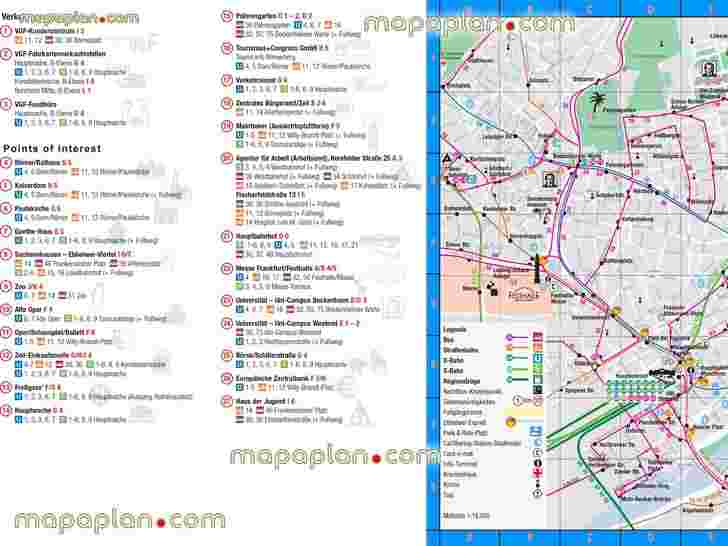
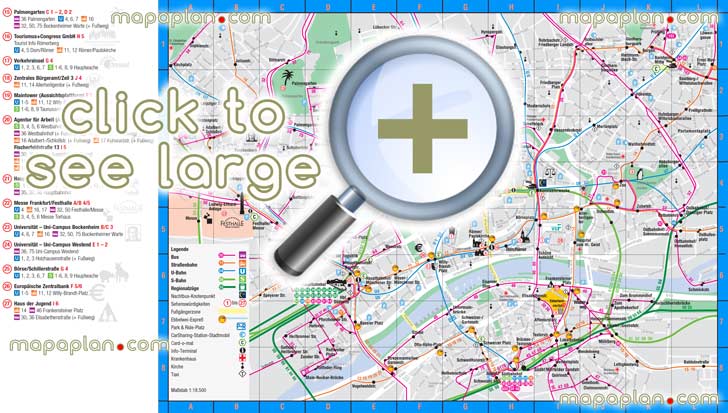
Maps of best attractions in Frankfurt am Main, Germany
Frankfurt maps will guide you to the best destinations in the city. The centre of Frankfurt is easily recognizable on a map, surrounded by green spaces called Anlagen. The major shopping streets intersect at the Hauptwache, while the skyscrapers of the financial district are located in the Taunusanlage and Gallusanlage to the west. Further west still is the Bahnhofviertel around the main train station, which is where many of the hotels are located. Frankfurt’s major historic sites are close to the north bank of the River Main, where the carefully reconstructed Romerberg square provides the focus; across the river is Sachsenhausen, home to the city’s celebrated Apfelwein taverns and to most of its museums. Frankfurt's top sights and key landmarks to visit are plotted on our detailed city plans. Public transportation points are also marked, and indicated by the symbols listed in the maps key. Armed with these maps, you should be able to find the accurate location of must-see places. Mapping out a trip to explore Frankfurt can be far from the usual. This page includes a range of maps and plans which will help you make the most of your visit to Frankfurt. If you are either a first-time tourist looking for the top 10 must-do sights or if you are returning to Frankfurt to discover something new - all you need to ensure an enjoyable trip is some advance planning. For some help in narrowing down the options, we present you with a range of high resolution maps which will help you find the detailed locations of the must-see sights - just click on a selected map to access a large version that can be downloaded and printed, or saved onto your mobile device. When in Frankfurt, you can also get free pocket-size maps of the city from the tourist information centres.
Frankfurt am Main, Germany city center free printable interactive visitor's detailed map download for tourists showing old town (Innenstadt Karte), must-see sights, S-Bahn & U-Bahn public transport stations & stops - Inner city plan showing sightseeing places of interest - Frankfurt top tourist attractions map
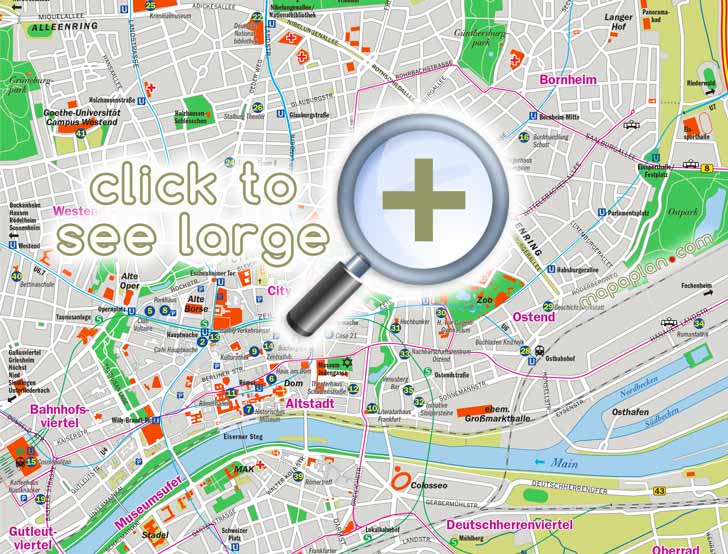
You can view, download or print a full, high resolution (detailed, large) version of this image by clicking on the plan itself
Central Frankfurt offline popout English guide & detailed downloadable map of tourist information, museums, sights, theatres, Romer, Hauptbahnhof, metro stations, shopping, inner city centre top attractions, best historical buildings - What to see, where to go, directions to interesting things to do - Frankfurt top tourist attractions map
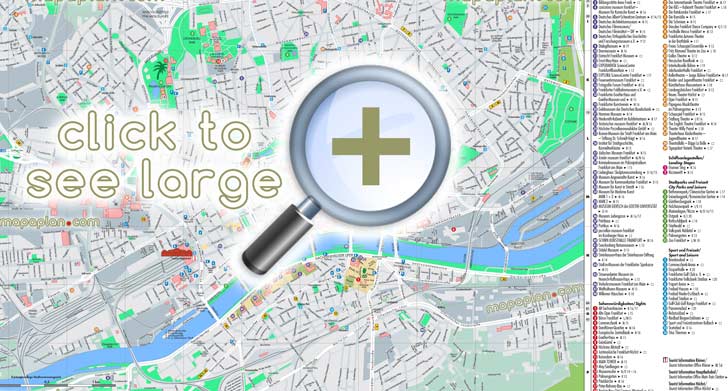
You can view, download or print a full, high resolution (detailed, large) version of this image by clicking on the plan itself
Frankfurt centre printable detailed map of attractions showing Romer, Cathedral, Hauptwache Street, Old Opera House, Banking District, tourist information in English - Interactive virtual guide map showing must-see places - Travel layout English guide free download - Offline map showing attractions & places to visit - Frankfurt top tourist attractions map
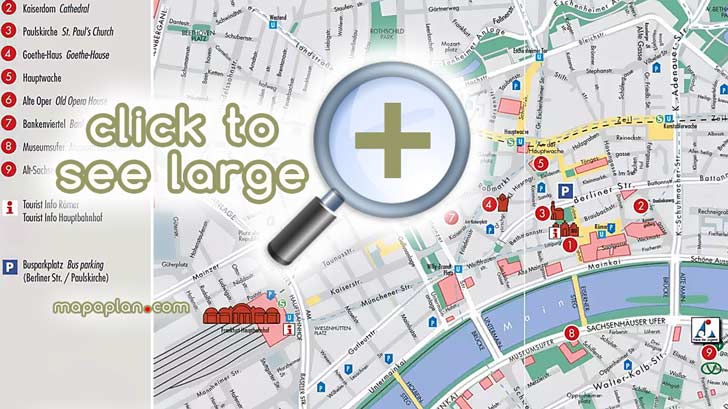
You can view, download or print a full, high resolution (detailed, large) version of this image by clicking on the plan itself
Map of Frankfurt S-Bahn, U-Bahn (metro, subway, underground, tube), tram (Strassenbahn), RMV public transport network map (Strassenbahn, Liniennetz plan) - Light rail stations, zones, railway routes, stops, updated transit diagram, suburban train, Airport - Frankfurt top tourist attractions map
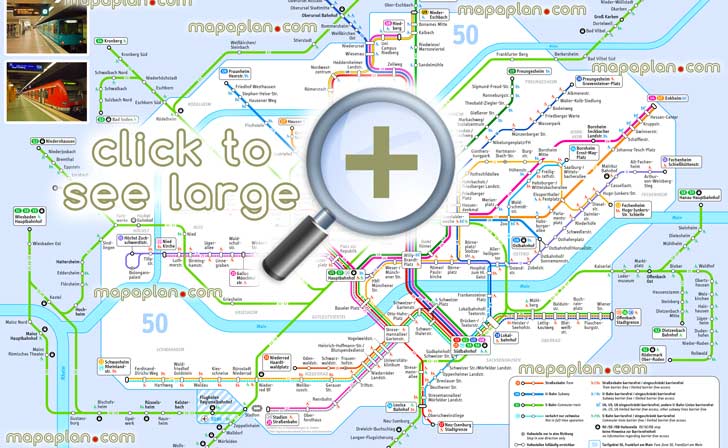
You can view, download or print a full, high resolution (detailed, large) version of this image by clicking on the plan itself
Hop-on hop-off bus map of Frankfurt city sightseeing tour for tourists - Visitor's 3d virtual interactive information plan with main points of interest, museums, landmarks - Double decker open top couch visitors' plan showing tour routes - Bird's eye graphical overview of the city trip highlights - Frankfurt top tourist attractions map

You can view, download or print a full, high resolution (detailed, large) version of this image by clicking on the plan itself
Frankfurt city centre free interactive printable detailed map showing top tourist attractions, hotel accommodation, main train railway station, restaurants, popular nightlife sites, street names, must-see destinations - Visitor's guide map showing metro stations and best of Frankfurt top points of interest - Free to download street & road names detailed hd map - Frankfurt top tourist attractions map
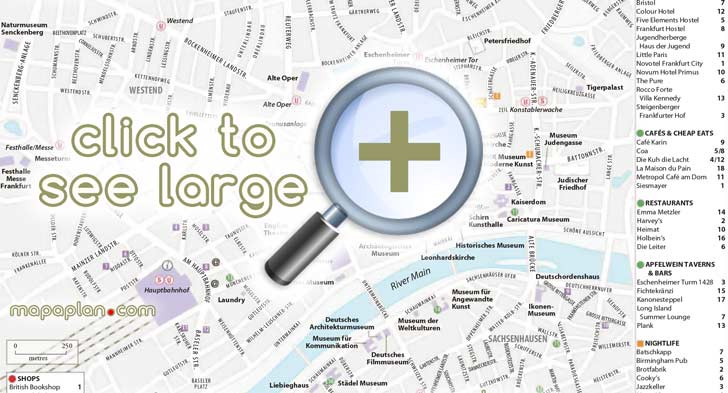
You can view, download or print a full, high resolution (detailed, large) version of this image by clicking on the plan itself
Frankfurt old city centre top attractions including Romerberg, Alte Oper - Historic centre printable sightseeing map with the list of points of interest in old town district area neighbourhood - High quality road guide & street names large scale plan - Itinerary planner with navigation to best sights, travel sites, landmarks, art galleries - Frankfurt top tourist attractions map

You can view, download or print a full, high resolution (detailed, large) version of this image by clicking on the plan itself
Frankfurt city center & old town free printable detailed guide street map showing locations of top attractions, location of tourist information office, great historic spots, best must-see sights - Virtual interactive 3d aerial satellite view map showing orientation & navigation directions - Frankfurt top tourist attractions map
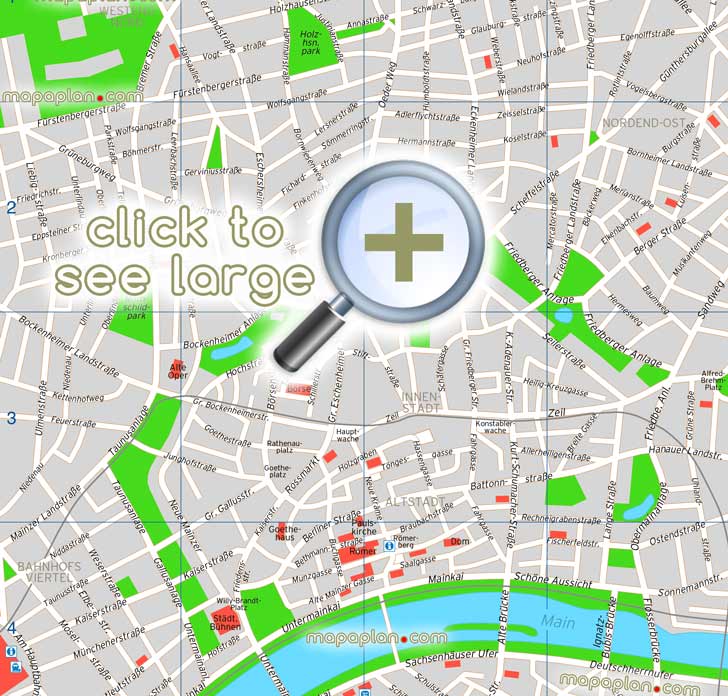
You can view, download or print a full, high resolution (detailed, large) version of this image by clicking on the plan itself
Frankfurt city center 3d interactive guide jpg map of main street, sightseeing downtown attractions, S-Bahn & U-Bahn stations - Interactive walking trip downloadable itinerary planner to print & guide map showing best destinations to visit - Central district area outline layout map of best locations - Frankfurt top tourist attractions map

You can view, download or print a full, high resolution (detailed, large) version of this image by clicking on the plan itself
Frankfurt am Main on the map of Germany, Europe - Visitor's detailed virtual printable guide to download - City street plan showing S-Bahn & U-Bahn metro subway stations - Walking tour guide itinerary planner map with favourite attractions & points of interest to visit by tourists - Frankfurt top tourist attractions map
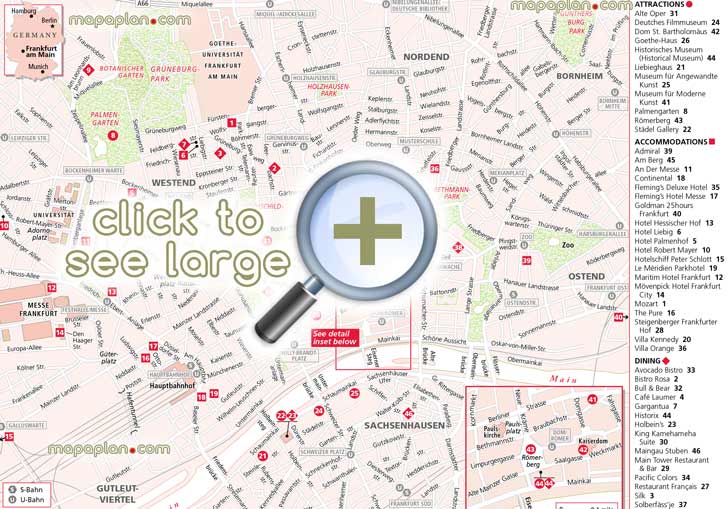
You can view, download or print a full, high resolution (detailed, large) version of this image by clicking on the plan itself
Frankfurt old town and inner city center (Altstadt & Innenstadt) free to download interactive map of interesting sights, simple & easy to navigate diagram showing holiday top points of interest, central walkable sites, city-break historical places to visit, walking tour guide itinerary planner showing layout of best things to do - Frankfurt top tourist attractions map
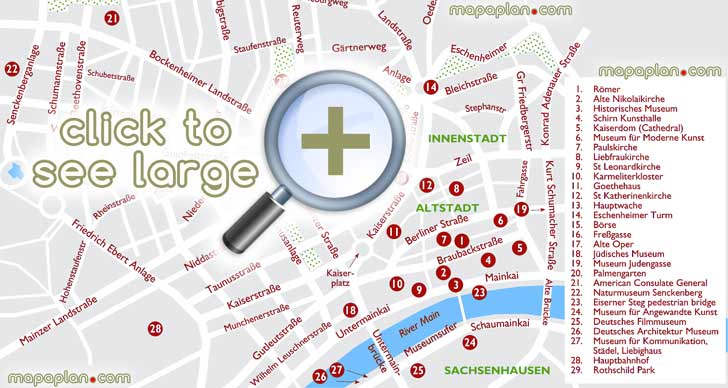
You can view, download or print a full, high resolution (detailed, large) version of this image by clicking on the plan itself
Frankfurt location on the map of regions of Germany - Frankfurt top tourist attractions map
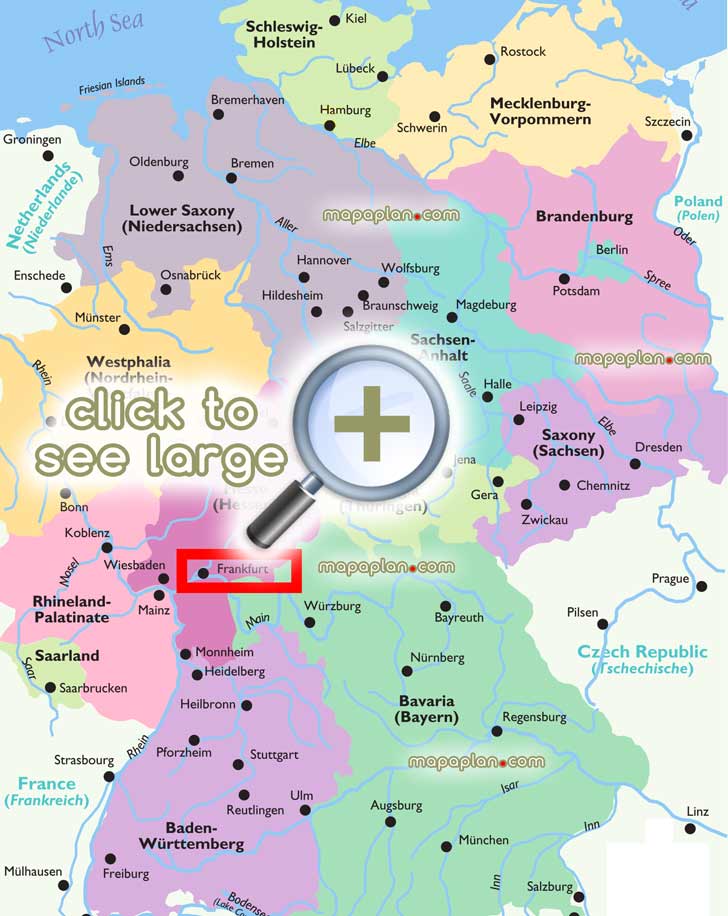
You can view, download or print a full, high resolution (detailed, large) version of this image by clicking on the plan itself
Frankfurt & Main River metropolitan area & nearby cities free to download map showing Airport, main neighbourhoods - Frankfurt top tourist attractions map
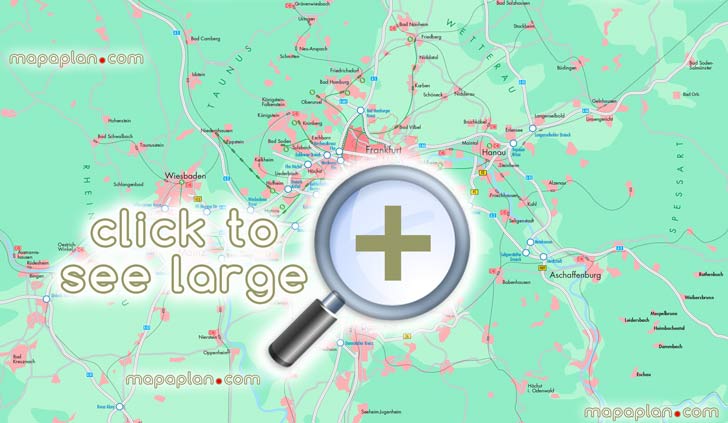
You can view, download or print a full, high resolution (detailed, large) version of this image by clicking on the plan itself
City map (Stadtplan Karte) of Frankfurt, Germany showing road & street names - 1-day trip travel locations to visit, must-see tourist attractions, famous destinations, must-do spots & landmark destinations - Download the free virtual explorer plan showing interesting sites & hot spotsworth visiting - Frankfurt top tourist attractions map
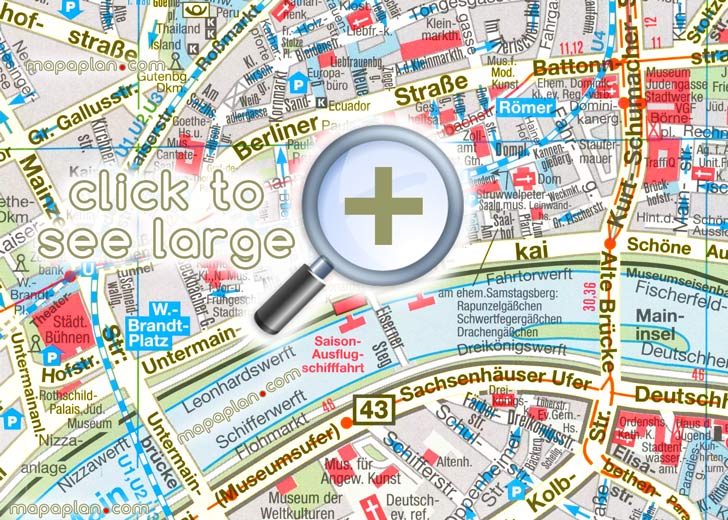
You can view, download or print a full, high resolution (detailed, large) version of this image by clicking on the plan itself
Map of top 10 attractions in Frankfurt
The typical top ten attractions are listed below. You can find the detailed locations of these places on the maps above.
- Old Town / Old city (Altstadt) - Allow about half a day to explore the old town. Its specific attractions include the Goethe Haus, which was the birthplace of Germany's greatest writer in 1749. Among the more intriguing sights is the Dom (detailed below), which used to serve as the electoral site for the kings of the Holy Roman Empire.
- Romer Square (Romerberg, Romer Platz, Frankfurter Romer) - Frankfurt am Main is centred around the Romerberg – a square surrounded by attractive half-timbered houses. Located in the centre of Frankfurt's old town, this square contains the Gerechtigkeitsbrunnen (Fountain of Justice). Its highlight, however, is the Romer (literally the Roman). It includes the Altes Rathaus (old town hall), which was rebuilt after World War II. Opposite is a group of halftimbered houses, commonly referred to as Ostzeile. The recently reconstructed Steinernes Haus is now the home of the Frankfurter Kunstverein (artists' league).
- Old Opera House (Alte Oper) - The monumental old opera house stands near the Stock Exchange. Built in 1872–80, it was completely burned down during World War II. Subsequently rebuilt, it is today used as a conference centre.
- Eschenheim Tower (Eschenheimer Turm) - The Eschenheimer Turm, at the corner of Hochstrasse, presents a silhouette typical of old Frankfurt. The facade of the tower features reliefs of eagles, the symbol of the German empire and the city of Frankfurt.
- Palm Garden (Palmengarten) - Providing a lush, green context for the Westend's affluent streets, the Palmengarten beyond Bockenheimer Warte is a splendid botanical garden of the old school, with prodigious flower beds and a series of hothouses accommodating plants of various habitats, from mangrove swamp to semi-desert and alpine.
- MyZeil - West of the Hauptwache, chic Goethestrasse is lined with luxury boutiques, while to the east stretches Zeil, one of the busiest shopping streets in Germany. The brash new MyZeil mall incorporates skyscrapers and – rather more improbably – a reconstruction of the destroyed Baroque Thurn und Taxis Palais around the corner on Grosse Eschenheimer Strasse.
- Mainhattan - In the financial district a giant illuminated Euro symbol stands at Willy-Brandt-Platz, its backdrop of banking towers marking the nexus of Frankfurt's financial district.
- Old Nicholas Church (Alte Nikolaikirche) - Popular attractions are its many statues of St Nicholas (Santa Claus) and the 40-bell carillon, which twice a day plays German folk songs.
- Stock Exchange (Borse at Borsenplatz) - According to historical records, local merchants founded the town's first Stock Exchange in 1558. The new building is open to the public.
- Hauptwache - The Hauptwache was originally a guardhouse. Later it was turned into a prison. Since 1904 the Hauptwache has been a chic café and a popular meeting place.
- Goethe House (Goethehaus) - Southwest of the Hauptwache is Johann Wolfgang Goethe's family home. The adjacent building now houses the Goethe Museum.
- St. Paul's Church (Paulskirche) - Immediately to the north of the Romer the circular Neoclassical Paulskirche. Today this building is no longer thought of, or indeed used as, a church. The Paulskirche now serves as a venue for many important events. Each year the awards ceremony for the prestigious German Publishers' Peace Prize takes place here.
- Cathedral (Kaiserdom) - The famous dome-topped West tower of the Kaiserdom (also known as Bartholomaus-Dom / Cathedral of St. Bartholomew) dominates the Altstadt.
- Jewish Museum (Judisches Museum) - The Jewish community of Frankfurt was the second largest in Germany, after that of Berlin. This museum, in the former Rothschild Palace, documents the rich cultural heritage of Frankfurt's Jews.
- St. Leonhard's Church (St Leonhardskirche) - Close to the banks of the Main stands the church of St Leonhard, a fine example of Gothic and Romanesque architecture.
- Historical Musuem (Historisches Museum) - The museum has an interesting display of items relating to Frankfurt's history, including a fascinating model of the medieval town layout, a collection of local prehistoric finds and several decorative architectural fragments from buildings that were destroyed during World War II.
- Natural History Musuem (Naturmuseum Senckenberg) - This museum, near the university, is one of the best natural history museums in Germany. Besides a vast collection of plants and animals, including dinosaur skeletons, it contains human and animal mummies from Egypt.
- Liebieg Sculpture Museum (Liebieghaus) - The Liebieghaus was built in 1896 for the Czech industrialist Baron Heinrich Liebieg. Today it houses a museum of sculpture, with works ranging from antiquity through to Mannerism, Baroque and Rococo. The museum also has superb examples of ancient Egyptian and Far Eastern art, as well as works from the Middle Ages and the Renaissance.
- German Architecture Museum (Deutsches Architekturmuseum) - One of the most interesting museums in the Schaumainkai complex is undoubtedly the museum of architecture. The museum has a permanent collection as well as temporary exhibitions concentrating mainly on developments in 20th-century architecture. Nearby, at No 41 Schaumainkai, is the German Film Musuem (Deutsches Filmmuseum), which holds documents and objects relating to the art of filmmaking and the development of film & cinema technology.
- Modern Art Museum (Museum für Moderne Kunst, MMK) - MMK occupies a building that looks like a slice of cake. The museum's collection represents all the major artistic trends from the 1960s until the present day, and includes works by Roy Lichtenstein & Andy Warhol.
- Other popular destinations include: Mainkai Street, Frankfurt am Main Hauptbahnhof, Berger Street (Berger Strasse), Chinese Garden, Stäael Museum, Museum fur Kommunikation, Ikonen-Museum, Westend, Commerzbank & Maintower, Museum für Angewandte Kunst (Museum of Applied Arts), Galerie Adler, Karstadt, Kaufhof, Frankfurt Zoo, Neustadt.
What are some interesting facts about Frankfurt?
Tourist information - Tourist offices are located opposite the main entrance at the main train station (Hauptbahnhof) and also in the city centre (Romerberg in the Altstadt, Innenstadt). You can get updated public transport and large tourist maps there.
Sightseeing - The main sights in Frankfurt are concentrated in the old town center, with several museums on the opposite bank of the Main in Sachsenhausen. There are a few more sights in the surrounding Neustadt, which was still within the old city walls. Most of the skyscrapers are in the Bankerviertel, but these are best seen from a distance, especially from the banks of the river. If time is limited, give priority to Romer and the Kaiserdom, the view of the skyline from the Eiserner Steg (a pedestrian bridge), and the Städel Art Museum.
Orientation - Most of Frankfurt's sights, nightlife, restaurants, and hotels lie in the Stadmitte (town center). The Main River flows from east to west, with the Altstadt (old city) and the Innenstadt (city centre) to the north and the Sachsenhausen district, including the Museumsufer (Museum Embankment), to the south. Frankfurt Hauptbahnhof (the main train station), on the eastern side of the partly sleazy Bahnhofsviertel (train station quarter), is about 1.3km west of the Romerberg, a historic public square marking the centre of the Altstadt. About 500m to the north of the Romerberg, the pedestrianised, east–west Zeil is the city's main shopping street and links two important U- and S-Bahn stations with adjacent public squares, Hauptwache and Konstablerwache. Head northwest from the Innenstadt along Bockenheimer Landstrasse and you get to the well-off Westend neighbourhood and then, 2km northwest of Hauptwache, Bockenheim, home to the university's new and old campuses, respectively. North and northeast of Konstablerwache are the Nordend and Bornheim districts. The airport is 12km southwest of the city centre.
Getting around - After you arrive in the Altstadt, you can easily get everywhere, including the Museumsufer on the opposite bank of the river, on foot. Nearly all the main sights lie within the boundaries of the old town walls, which today form a stretch of narrow parkland, almost a perfect half-moon around the Altstadt or old city. For longer distances, you can take the U-Bahn (subway), S-Bahn (tram), or a bus.
Public transportation - A network of modern subways (U-Bahn consisting of U1, U2, U3, U4, U7, U8 and U9), light trains (S-Bahn), trams (Strassenbahn), and buses, administered by the Rhein-Main Verkehrsverbund (RMV), links Frankfurt. All forms of public transportation can be used interchangeably at a single price based on fare zones. For sightseeing in the old town, the U-Bahn is usually the most convenient. Bus 46 runs from the Hauptbahnhof along the Schaumainkai where most of the Sachsenhausen museums are located.
Shopping - Frankfurt has several shopping areas. The Zeil, a pedestrian zone between the Hauptwache and Konstablerwache, is loaded with department stores, clothing shops, shoe stores, record stores — in short, just about everything. Shoppers generally pack the Zeil, reputedly the busiest shopping street in Germany. The Hauptwache, in the center of Frankfurt, has two shopping areas, one above and one below ground. Schillerstrasse, another pedestrian zone, lies between Hauptwache and Eschenheimer Turm, near the stock exchange. Walking from Schillerstrasse northeast toward Eschenheimer Tor, you pass many elegant boutiques and specialty shops. Southwest of the Hauptwache is Goethestrasse, with exclusive stores evocative of Paris or Milan.
How can I find specific tourist attractions on the map of Frankfurt?
Our interactive city maps are easy to explore. You can pan, zoom in, and zoom out on the high-resolution map to locate major tourist attractions. Each map highlights key landmarks, making it simple to find the sights you're most interested in, whether it's a famous monument, museum, or other point of interest.
Can I get a visual representation of the area around Frankfurt?
For some cities, we provide a general view of the area surrounding popular attractions. While this image won't show the exact street-level view, it helps you understand the layout of the neighborhood, showing how the landmarks are situated in relation to other points of interest around Frankfurt.
Can I explore maps for both tourist attractions and other points of interest?
Yes! Our platform offers maps covering a range of highlights, from top tourist attractions to other noteworthy areas such as parks, restaurants, and entertainment venues. Whether you're planning a visit to a museum or looking for a nearby park, our detailed maps make it easy to find the best spots in the city.
Related keywords
2023, 2024, 2025, 2025, 2026, 2027, 2028, 2029, map, plan, download, print, printable, free, detailed, aerial, bird's eye, satellite, guide, planner, travel, sightseeing, visit, trip, tour, tourist, what to do, where to go, things to do, must see, top attractions, points of interest, places, sites, sights, buildings, spots, destinations, locations, landmark, museum, in a week, in 3 days, one day, city, route, bus, kids, children, top 10, top ten, popular, famous, interesting, highlights, public transport, rail, hotels, updated, metro, subway, underground, tube, downtown, coach, nightlife, pub, monument, satellite, accommodation, transit, transportation, supermarket, children, metro, subway, underground, tube